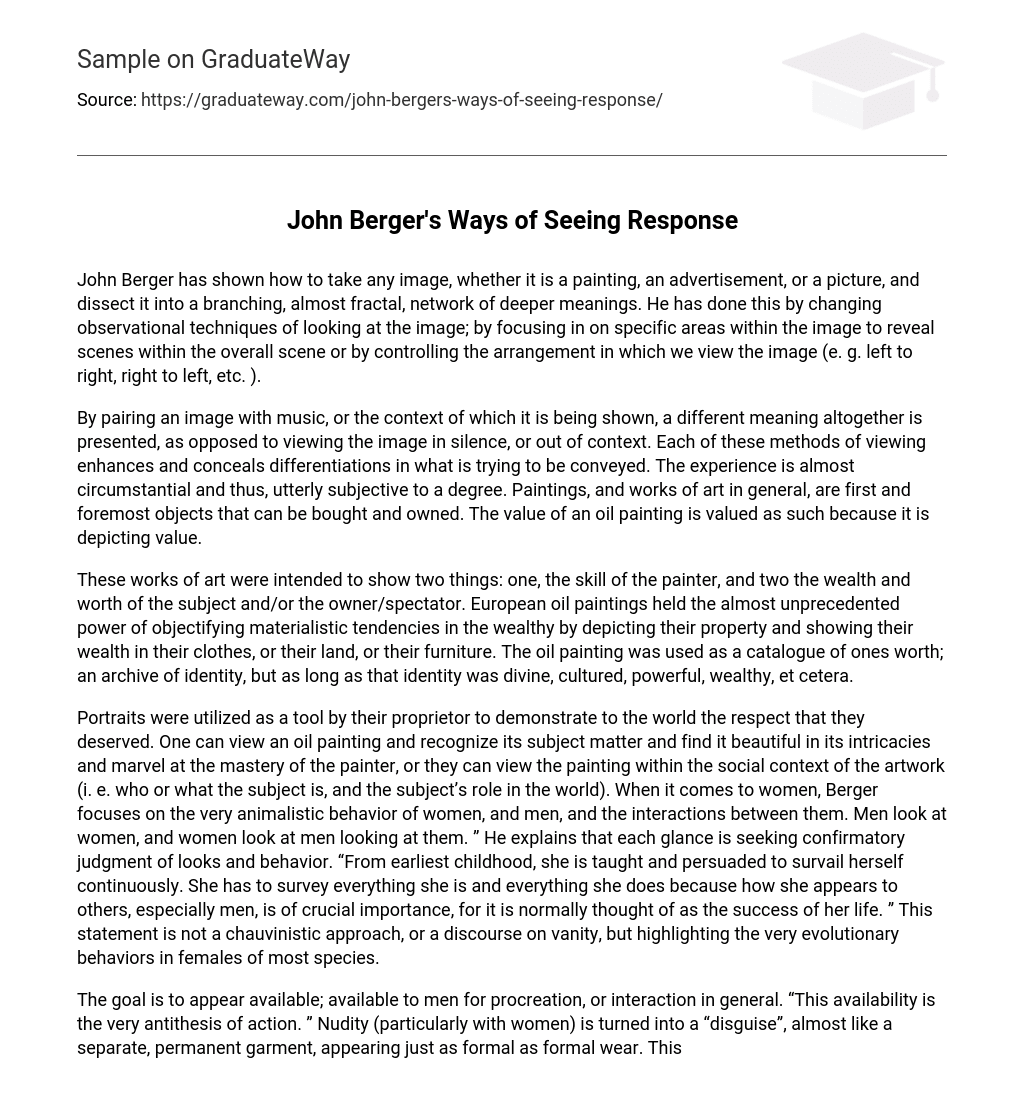John Berger demonstrates the ability to analyze and interpret various types of images, including paintings, advertisements, and pictures. He accomplishes this by utilizing alternative methods of observing the image. By examining specific areas within the image, he unveils intricate scenes that exist within the larger context. Additionally, Berger controls the presentation of the image, determining the order in which we perceive it (e.g., left to right or right to left).
By combining an image with music or its specific presentation, the conveyed meaning differs significantly from viewing the image in silence or without any context. Each of these modes of observation both enhances and hides various nuances in the intended message. The overall experience is highly subjective and dependent on individual circumstances. Paintings and artworks, in general, are primarily physical objects that can be purchased and possessed. The worth of an oil painting lies in its representation of value.
These works of art were meant to showcase the painter’s skill and demonstrate the wealth and importance of the subject or owner/spectator. European oil paintings had the unique ability to visually represent materialistic tendencies in the wealthy by depicting their possessions and displaying their wealth through their attire, land, or furniture. The oil painting served as a record of one’s value and a storehouse of identity, as long as that identity was associated with qualities such as divinity, culture, power, and wealth.
The portraits served as a means for their owners to demonstrate the respect they deserved. An oil painting can be appreciated for its subject matter and intricate beauty, as well as the skill of the artist. Alternatively, one can analyze the painting within its social context, considering the identity and role of the subject. In regard to women, Berger focuses on the primal behavior exhibited by both women and men, as well as their interactions. Men observe women while women observe men observing them. Berger explains that each gaze seeks validation in terms of appearance and behavior. From a young age, women are taught and influenced to constantly monitor themselves. How they present themselves to others, particularly men, is considered crucial for their success in life. This statement does not promote chauvinism or vanity but rather sheds light on the evolutionary behaviors typically observed in females across species.
The objective is to present oneself as accessible, whether it be for procreation or general interaction. This accessibility is contrary to taking action. When it comes to women, nudity is transformed into a type of disguise, comparable to a permanent garment that appears equally formal as traditional attire. As a result, any sense of being undressed is removed, preventing the women depicted in the showcased works from being fully exposed. Being “nude” becomes just another form of attire, similar to that of a working woman or a maternal figure, although it carries the implication of being prepared for sexual activity.
Advertisements are a prime example of subjectivity, as their purpose is to present a different lifestyle, which each viewer interprets based on their own circumstances. These ads often serve as aspirations for viewers to attain a life they have not yet achieved. The contrast between capitalistic ads and European oil painting portraits is striking.
The portraits were utilized to demonstrate power through wealth or authority, while advertisements generate jealousy and incentivize individuals to exchange their money for products that can provide power and happiness. Publicity has converted money into a deity-like entity that not only elevates social standing but also heightens appeal to the opposite gender. Instead of endorsing individual power, advertisements fabricate idealized futures that satisfy a feeling of insufficiency and promise contentment and acceptance. Once attained, individuals no longer need to concern themselves with their societal status. Essentially, imagery possesses the ability to metamorphose and elicit emotions in the observer.
The perception of an image differs among individuals because of their social background or personal experiences, resulting in each person seeing the same image differently. The process of transforming an image happens as it transitions from one person to another, from canvas to film, or from gallery to mantelpiece. Although an image may be visually appealing on its own, its interpretation can significantly shift when viewed within the context of its subject matter. When displayed to a audience, a single captured moment in an image becomes more captivating and enduring.





